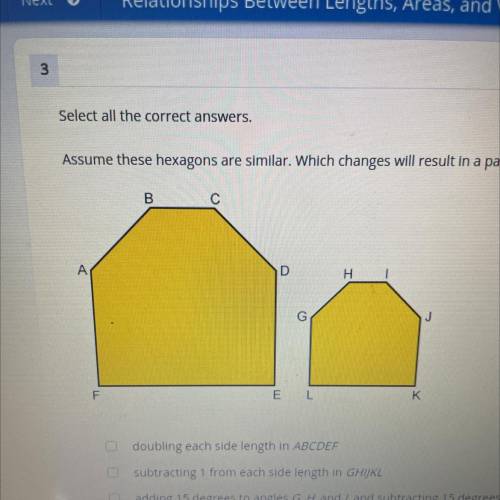
Mathematics, 21.04.2021 20:30 jessicawelch25
Assume these hexagons are similar. Which changes will result in a pair of non-similar hexagons?
B
с
A
D
H
G
F
E
L
K
doubling each side length in ABCDEF
subtracting 1 from each side length in GHIJKL
adding 15 degrees to angles G, H, and I, and subtracting 15 degrees from angles ), K, and L
reducing each side length in GHIJKL by one-third of the original length
O adding 3 to each side length in GHIJKL


Answers: 1


Another question on Mathematics

Mathematics, 21.06.2019 18:00
The given dot plot represents the average daily temperatures, in degrees fahrenheit, recorded in a town during the first 15 days of september. if the dot plot is converted to a box plot, the first quartile would be drawn at __ , and the third quartile would be drawn at __ link to graph: .
Answers: 1

Mathematics, 21.06.2019 18:00
Name each raycalculation tip: in ray "ab", a is the endpoint of the ray.
Answers: 2

Mathematics, 21.06.2019 19:00
What is the correlation coefficient between the variables? round to three decimal places. enter your answer in the box
Answers: 2

Mathematics, 21.06.2019 19:00
What will the graph look like for a system of equations that has no solution? a. the lines will be perpendicular. b. the lines will cross at one point. c. both equations will form the same line. d. the lines will be parallel.
Answers: 1
You know the right answer?
Assume these hexagons are similar. Which changes will result in a pair of non-similar hexagons?
B<...
Questions


English, 10.11.2020 04:10


Physics, 10.11.2020 04:10



Advanced Placement (AP), 10.11.2020 04:10


Mathematics, 10.11.2020 04:10



Mathematics, 10.11.2020 04:10

Mathematics, 10.11.2020 04:10



Spanish, 10.11.2020 04:10


Mathematics, 10.11.2020 04:10




